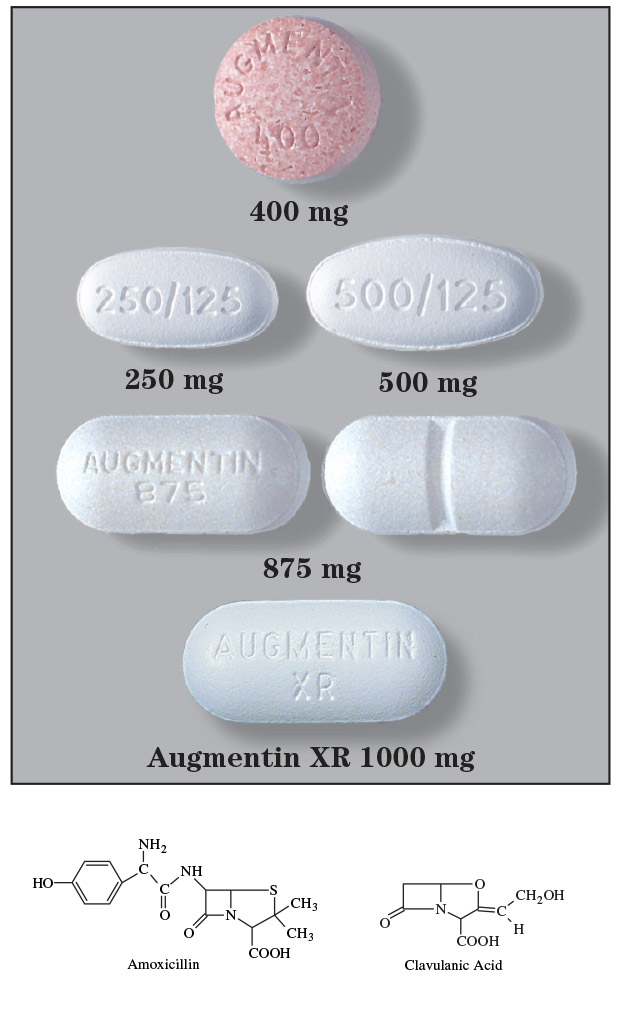ə/moks’i/s’il in with kla/vyū/lan’āt
Brand Name: Augmentin® & Augmentin XR
• Generic AvailableCommon Dosage Forms:
| Tablets and chewable tablets: | Amoxicillin | Clavulanic Acid |
| Augmentin ‘250’ Tablets | 250 mg | 125 mg |
| Augmentin ‘500’ Tablets | 500 mg | 125 mg |
| Augmentin ‘400’ Chewables | 400 mg | 57 mg |
| Augmentin XR Extended-Release (scored) | 1000 mg | 62.5 mg |
| Oral Suspension (per 5 mL following reconstitution): | Amoxicillin | Clavulanic Acid |
| Augmentin ‘125’ | 125 mg | 31.25 mg |
| Augmentin ‘250’ | 250 mg | 62.5 mg |
| Augmentin ES-600 | 600 mg | 42.9 mg |

FDA Indications/Dosages:
- Sinusitis and otitis media due to beta-lactamase producing strains of H. influenzae and B. catarrhalis; lower respiratory tract infections due to beta-lactamase producing strains of H. influenzae, skin and skin structure infections due to beta-lactamase producing strains of Staphylococcus aureus, E. coli and Klebsiella species, and urinary tract infections due to beta-lactamase producing strains of E.coli,Klebsiella species and Enterobacter species: Adults (less severe infections): One Augmentin ‘250’ every eight hours or one Augmentin ‘500’ tablet every twelve hours. Adults (more severe infections): One Augmentin ‘500’ every eight hours or one Augmentin ‘875’ tablet every twelve hours.
- Children: 25 to 45 mg/kg/day, based on the amoxicillin component, in equally divided doses twice a day.
- Recurrent acute otitis media due to Streptococcus pneumoniae (penicillin MICs ≤ 2mcg/mL), Haemophilus influenzae, or Moraxella catarrhalis characterized by antibiotic exposure for AOM within the prior 3 months and either age ≤2 years or day care atten- dence: Augmentin ES-600 at doses of 90 mg/kg/day divided every 12 hours.
- Acute bacterial sinusitis or community-acquired pneumonia due to confirmed beta-lacta- mase producing strains of susceptible bacteria: Two Augmentin XR tablets every 12 hours for 10 days (sinusitis) or 7-10 days (pneumonia). Should be taken with meals.
Pharmacology/Pharmacokinetics:
Amoxicillin is a bacteriocidal antibiotic which inhibits bacterial cell wall synthesis via acylation of a transpeptidase enzyme. This acylation occurs in the third and final stage of bacterial cell wall synthesis and is believed to be due to the structural similarity of the penicillin nucleus to D-alanyl-D-alanine. Clavulanic acid binds competitively to the active sites of beta-lactamase enzymes, thereby protecting penicillins and cephalosporins from destruction. Distribution occurs to most body tissues excluding CSF except when meninges are inflamed. Half-life is one hour. Peak blood levels are reached in 1-2 hours. Excretion occurs as unchanged drug in the urine. Only 20% is bound to plasma proteins. Clavulanic acid is absorbed more readily when taken with food.
Drug Interactions:
Changes in GI flora may disrupt the absorption of oral contraceptives. Theoretically, amoxicillin should not be used with bacteriostatic antibiotics because bactericidal antibiotics depend on the rapid growth of bacteria to exert their pharmacological effect. Renal excretion of amoxicillin will be decreased by probenecid.
Contraindications/Precautions:
Contraindicated in patients hypersensitive to peni- cillins and/or cephalosporins. The estimated incidence of cross-sensitivity is 5% to 16%. Use with caution in patients with renal function impairment. Cases of pseudomembranous colitis andClostridium difficile associated disease have occurred during treatment with cephalosporins. Persistent or severe diarrhea should be reported to a physician. Since both 250 and 500 tablets contain 125 mg clavulanic acid, two 250 tablets do not equal one 500 tablet. Substitution of two 250 tablets for one 500 tablet may result in excessive amounts of clavulanic acid in the blood stream. Pregnancy Category B.
Adverse Effects:
Nausea, vomiting, DIARRHEA, hives, itching, and RASH.
Patient Consultation:
- Preferably taken at the start of a meal to enhance absorption and decrease GI upset.
- Take at even intervals, preferably around the clock.
- Complete full course of therapy unless otherwise directed.
- Follow chewable tablets with a full glass of water.
- Keep suspension refrigerated, discard after 10 days.
- Shake suspension well before each dose.
- If a dose is missed, take it as soon as possible.
- Contact a physician if the above side effects are severe or persistent.